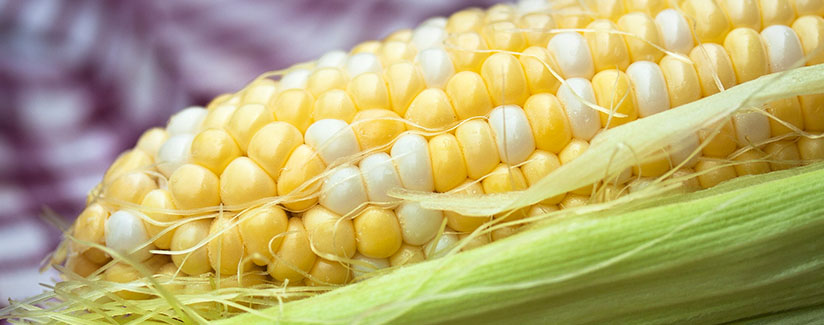
Genetically-Engineered Sweet Corn – Is It Safe?
04/16/2012
A recent blog post from Food & Water Watch in the The Huffington Post raised concerns about genetically-engineered (GE) sweet corn. Previously, we posted information from experts regarding the effect of GE foods on human health. We asked these experts to weigh in on the GE sweet corn issue.
- Dr. Bruce Chassy – University of Illinois
- Dr. Wayne Parrott – University of Georgia
- Dr. Alison Van Eenennaam – University of California-Davis
Is genetically engineered sweet corn safe for human consumption?
Dr. Van Eenennaam:
The National Academy of Sciences and other leading research institutions agree that GE foods present no unique risks, or greater risks, than non-GE foods. In fact, because GE foods are intensively tested for safety while most other foods are not, GE foods are probably safer than most foods on the market today.
Dr. Chassy:
Genetically-engineered foods are rigorously tested before marketing. These tests are designed to ensure there are no adverse effects on human health now or in the future. The Huffington Post’s blog fails to recognize this. There is an abundance of scientific evidence and published research, as well as more than 15 years of experience with GE crops that provide strong evidence of their safety. There is no credible scientific evidence that they cause allergies or that they would have any long-term health effects.
Dr. Parrott:
GE sweet corn is every bit as safe as conventional sweet corn. It uses a protein that has been used in agriculture since 1937. Not only does it have a history of safe use, it has been extensively tested by HealthCanada, the European Food Safety Authority, the Korean FDA, Food Standards Australia & New Zealand, & the Japan Food Safety Commission, among others. All reports to the contrary do not hold up under close inspection.
The blog post states that “superweeds and pests have become resistant to GE-affiliated herbicides and pesticides and require many more toxic chemicals to be applied to crops.” Is this true?
Dr. Chassy:
I’ll address this in two parts – first: superweeds. It is inaccurate to call emergence of a single herbicide resistance a “superweed.” A superweed (by definition) would actually be resistant to all or at least many herbicides. Resistance has occurred with many herbicides used on non-GE crops. Fortunately, that has not yet occurred with GM crops; multiple herbicide-resistant weeds have emerged in conventional crops through poor stewardship of herbicides. Where we have seen resistance to herbicides used in GE crops, (less than 1 percent of land planted with GM herbicide tolerant crops), alternative herbicides are still effective. The key requirement to minimize the emergence of resistance to the herbicides used on crops is careful management.
Second: toxic chemicals. Comprehensive data from all over the world demonstrates that planting GE crops has significantly reduced the amount of pesticides used on crops (Brookes and Barfoot, 2010). In addition, it has allowed a shift to far less toxic herbicides that are not persistent in the environment. The claim that more toxic chemicals are used because of GE crops is not supported by the evidence. One of the major reasons that farmers choose to pay more for GE seeds is that they end up paying less for chemicals, fuel, and labor. They also suffer less soil compaction in their fields, less soil erosion and water loss, and there are far less greenhouse gas emissions from their fields. If no-till methods that are facilitated by planting GE crops are used, it also improves soil organic carbon content.
Dr. Parrott:
There is evidence that rootworms are becoming resistant, but they are not there yet, and they may never get there. The other pests are not showing such signs.
Superweeds’ is a term coined to purposely exaggerate a problem, and it refers to a weed that has become resistant to an herbicide. By that definition, herbicides have been creating “superweeds” since they came into use after WWII. Any given herbicide has a lifespan of some 10 years before the weeds catch up. The worst case scenario is we go back to the chemicals we have used before. The claim that we will go to a more toxic agriculture than we had before is not valid.
Based on previous Best Food Facts coverage of this topic, we were under the impression that GE foods undergo extensive testing. Does this not include human safety tests?
Dr. Chassy:
It is correct that extensive compositional testing is done to assure that there is no loss of nutrients and no introduction or increase in potentially toxic compounds, anti-nutrients, or allergens. The safety of the new trait introduced into the crop is also carefully tested in the laboratory and in animals. Human safety tests are not used on whole foods because they lack sensitivity – just try to get a human to eat a diet that is 30 percent soybeans or 30 percent corn. Food safety experts, nutritional scientists and toxicologists have developed very effective methods for evaluating the safety of foods that are used for all novel foods and ingredients independent of whether they are GE. FDA concluded in 1980 that whole food studies in humans and animals are not recommended since they are of little value in predicting safety.
Dr. Parrott:
It turns out there are much better ways to test for safety. Working with humans is difficult: first, we do not have inbred laboratory strains of humans the way we have rats and mice. Getting humans to eat the same meal for days on end is difficult, and humans have lots of bad habits (ranging from lack of exercise to getting to bed too late) that can throw results off.
What about environmental health effects?
Dr. Parrott:
We have gone from using insecticides that killed any animal that happened to be there, to ones that just kill the pest. Likewise, when we monitor other indicators of sustainability, such as water use, greenhouse gas production, etc., GM crops have a lower environmental footprint.
Food allergies are mentioned in The Huffington Post blog. Is there any reason for concern over allergies to this sweet corn?
Dr. Chassy:
All GE crops are subjected to a thorough pre-market safety assessment which includes a systematic analysis of any potential to produce allergies before they come to market. There is no reason to believe that GE crops would give rise to allergies. The claim that they might produce, or have produced allergies, is misleading. There are no valid scientific reports that support this claim.
Dr. Parrott:
Remember that the active ingredient here has been used in agriculture since 1937. We have not found any allergy to it; no reason to think that it will act different in sweet corn than in regular corn or on other crops. Although The Huffington Post blog claims this is the first GM corn meant to be eaten on the ear, that is not the case. Field corn is consumed on and off the ear in many countries of Latin America.
Monsanto’s new sweet corn combines three genetically-engineered traits approved in 2005 and 2008 (corn-borer resistance, rootworm resistance and Roundup tolerance). The blog post states the sweet corn “…flew through the approvals process even though a vegetable with these three traits has never been consumed directly by people.” Should we be concerned about the approvals process?
Dr. Parrott:
Rootworm and corn-borer resistance come from Bt protein, which has been sprayed on vegetables for the past 80 years, and engineered into crops more recently, meaning their safety has been extensively reviewed around the world. As far as Roundup goes, all that was done is add a version of a gene that is already there; versions of this gene are naturally present in every single plant we eat. The fact they are in a vegetable will not make these traits behave differently than when they were together in field corn.
Dr. Chassy:
As stated before, we don’t do safety testing of whole foods in humans. Plant breeders frequently cross plants to combine traits. Years of experience have shown that if two safe to consume plants are crossed, the progeny will be safe too. The GE plants that were conventionally crossed to produce the new sweet corn variety were carefully scrutinized by the Environmental Protection Agency, the USDA, and the Food and Drug Administration before they were introduced into the market. The new corn is, in fact, not a new GE variety, since no new DNA was introduced into the plant. The most important fact to remember here is that there is no reason to expect that these traits will do anything different when combined than they did when they were present in three different safe and approved GE plants.
What about the statement that public opinion polls show a majority of consumers asked would not eat GE food if they had a choice and that 95 percent think GE foods should be labeled so they can make informed choices?
Dr. Van Eenennaam:
Although public opinion polls suggest that most Americans favor mandatory GE labeling in the abstract, this majority disappears when respondents learn the significant costs associated with labeling requirements. The burdens and disruptions that mandatory labeling imposes on the global food trade can cost millions of dollars per year. This leads to an unjustified and unnecessary tax on the entire food distribution chain, from farmers to consumers. Taking into account the costs of labeling laws, a strong majority of Americans opposes mandatory labeling.
Dr. Chassy:
If you really want to know what consumers think, you have to watch what they buy and eat. Very, very few Americans are seeking out and buying GE-free food. The International Food Information Council (IFIC) uses a much better technique (than was used in the Johns Hopkins research) in their surveys of consumer attitudes. They have consistently found over the years that when they ask consumers if there is anything not presently on labels that they would like to see on a label, less than 1 percent mention GE content or biotechnology; similarly, when asked what foods they were avoiding, GE foods are not mentioned.
Dr. Van Eenennaam:
Mandatory labeling does not offer consumers a choice between GE and non-GE foods. Instead, in every jurisdiction that has adopted mandatory labeling, GE foods have been pushed off the market by requirements that are expensive, burdensome, and stigmatizing – removing the option of choice. Furthermore, the authors argue that customers who wish to avoid GE foods can do so easily by purchasing food voluntarily labeled as “organic” or non-GE. Mandatory labeling is therefore unnecessary to ensure consumer choice.
What is the economic impact of labeling?
Dr. Van Eenennaam:
The cost of labeling involves far more than the paper and ink to print the actual label. Accurate labeling requires an extensive identity preservation system from farmer to elevator to grain processor to food manufacturer to retailer (Maltsbarger and Kalaitzandonakes, 2000). Either testing or detailed record-keeping needs to be done at various steps along the food supply chain. Estimates of the costs of mandatory labeling vary from a few dollars per person per year to 10 percent of a consumer’s food bill (Gruere and Rao, 2007). Consumer willingness to pay for GE labeling information varies widely according to a number of surveys, but it is generally low in North America. Another potential economic impact for certain food manufacturers is that some consumers may avoid foods labeled as containing GE ingredients.
From your unique standpoint, would there be any benefits to labeling genetically engineered food ingredients?
Dr. Chassy:
None whatsoever. It provides no meaningful or useful information to consumers. The label doesn’t say where the GE content came from, how much is there, or in what form it is in. It would be a statement void of scientific information. Studies show that consumers would interpret such a label as a government-mandated safety warning. Data also shows that localities and regions that have mandatory GE labels don’t have GE foods on supermarket shelves – instead, they have much more expensive GE-free foods, thus limiting choice for consumers.
Dr. Parrott:
It would be of great benefit to the food-testing industry, which would have a great market for its testing products all of the sudden, and which will have to pass its costs on to the consumers.




























